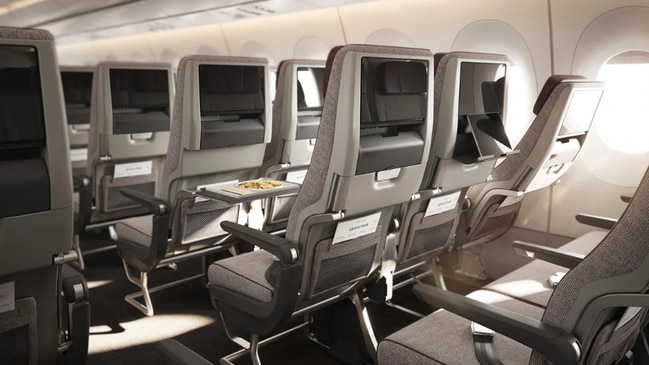How Airbus answered Qantas’ challenge for its Project Sunrise-capable aircraft
Tasked with the challenge of creating an aircraft to fly Qantas’ marathon Project Sunrise flights, Airbus took inspiration from the most aerodynamic creatures on the planet.
Business
Don't miss out on the headlines from Business. Followed categories will be added to My News.
Tasked with the challenge of developing an aircraft which could fly for more than 20 hours non-stop, Airbus engineers sought inspiration from the most aerodynamic creatures on the planet – birds.
The challenge arose from Qantas’s plan to launch non-stop flights from cities such as Sydney and Melbourne to New York and London, which was considered the “final frontier” of aviation.
Airbus senior vice-president of marketing Joost van der Heijden said the planned flights – known as Project Sunrise – would undoubtedly shape the future of air travel.
“It became a very gratifying experience of collaboration, of partnership, to shape this new chapter in aviation together and build this capability,” Mr van der Heijden said.
“Qantas challenged us, and they brought out the best in us.”
As a result, the first of 12 specially modified A350-1000s is due to roll off the production line by mid 2026.
Featuring a 20,000l third fuel tank to extend the A350’s range to almost 18,000km, the aircraft has wings that adapt to changes in flight for optimal aerodynamics.
“What you don’t see on the ground but you see in flight is a morphing wing concept,” Mr van der Heijden said.
“We call it biomimicry; we’ve tried to imitate the shape of the wings of a bird, the most aerodynamic creatures on the planet.”
Once the aircraft’s capability was sorted, Airbus and Qantas turned their attention to the next challenge which was ensuring crew and passengers could comfortably endure such long flights.
Mr van der Heijden said they were off to a head start, as the A350 has the “quietest twin aisle cabin on the market” and a cabin altitude of 6000 feet, but there was room for improvement.
Having collaborated with Qantas on Perth-London flights, Sydney University’s Charles Perkins Centre was asked to research optimal lighting, meals and physical activity required on 20-hour trips.

Circadian physics expert Associate Professor Sveta Postnova said that typically long-haul flights involved a meal after boarding followed by lights out, then a breakfast service before landing.
“When you have flights of more than 17 hours you can’t do that, because that means passengers are in the dark for 12 hours, which is not ideal,” Professor Postnova said.
“The schedules (on Project Sunrise flights) will really depend on the origin and destination, and the timing of the flight, but we will definitely try to have 10 hours of sleep, or 10 hours of darkness on those flights.”
In addition, a total of 12 lighting scenes would be applied to the marathon flights, for takeoff and landing, to help create a sense of calm and rest in the cabin (sunset), or to gently wake up passengers (sunrise).
“It’s great to see circadian science being translated into practice,” Prof Postnova said.
“The thinking from our side is if you can reduce jet lag even just by one day, given how many people fly that’s a pretty impressive impact on the productivity of society.”
Meals are being developed to enhance the effect of the light changes, with a focus on tryptophan-rich foods such as poultry, eggs and dairy paired with complex carbohydrates to prepare passengers for sleep.
“Tryptophan is a hormone that’s a precursor for melatonin and melatonin is our so-called darkness hormone, because it’s released during the night time, and some people even take melatonin pills to help the transition to sleep,” Prof Postnova said.
Passengers would be encouraged to get up and stretch in the wellbeing zone, designed to allow six people at a time to follow guided movement on television screens.
For crew, bespoke rest areas are being installed by Airbus with two bunks for pilots at the front of the cabin, and eight bunks for flight attendants at the rear.
Unlike other long-haul flights operated by Qantas, Project Sunrise services would for the first 12 months be crewed by one captain, two first officers and a second officer to help minimise fatigue.
Australian and International Pilots Association president Tony Lucas said the arrangement meant the takeoff and landing team (of captain and first officer) could rest at the same time, unlike routes such as Sydney-Dallas and Auckland-New York.
“When you have one captain, one first officer and two second officers, either the captain or first officer must be on the flight deck the whole time,” Captain Lucas said.
“It’s not to say those arrangements are unsafe when clearly they’re not; we’ve demonstrated that over many years, it’s about whether a different crewing matrix delivers a better fatigue outcome for crew.”
He said pilots were pleased Qantas would undertake research on fatigue levels in the first year of Project Sunrise flights and hoped that would lead to the “heavy crew” matrix being made permanent.
Originally published as How Airbus answered Qantas’ challenge for its Project Sunrise-capable aircraft





